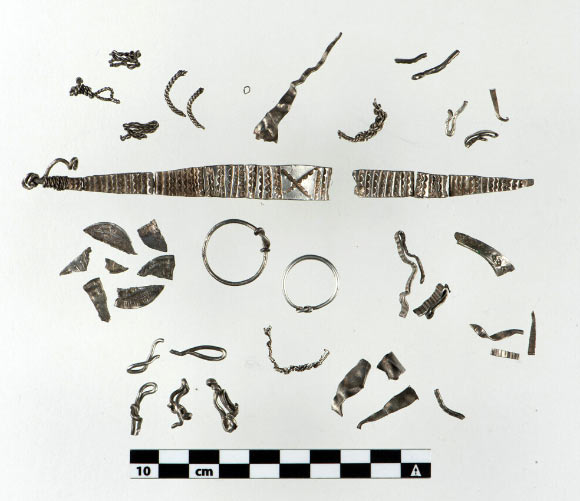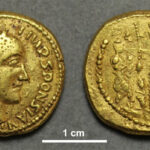A metal detectorist in Norway has unearthed a 1,100-year-old trove of small silver objects: pieces of Arab coins, jewelry and wire.
The Viking-age hoard consists of 46 silver objects; apart from two simple, complete finger rings, it includes Arab coins, a braided necklace, several bracelets and chains, all broken into small pieces. Image credit: Birgit Maixner.
The Viking-age hoard was found by the metal detectorist Pawel Bednarski at the Kongshaug plateau in the Stjørdal municipality, Norway.
“The first item I found was a small ring that didn’t look particularly interesting at first glance. Then another ring appeared — and then a piece of a bangle,” Bednarski said.
“The objects were covered in clay, so it wasn’t easy to see what they looked like. It was only when I got home and rinsed off one of the bangle pieces that I realized this was an exciting find.”
“This is quite an exceptional find,” added Dr. Birgit Maixner, an archaeologist at the Norwegian University of Science and Technology’s University Museum.
“Finding this big a treasure from the Viking Age hasn’t happened in Norway for a long time.”
The hoard consists of 46 silver objects: two finger rings, Arab coins, a braided necklace, several bracelets and chains, all cut into small pieces — also called hacksilver.
“This find is from a time when silver pieces were weighed and used as means of payment. This system is called the weight economy and was in use in the transitional period between the earlier barter economy and subsequent coin economy,” Dr. Maixner explained.
“Up until the Viking Age, a barter economy was common in the Nordic countries, but by the end of the 8th century CE, the weight economy was making inroads.”
“The weight economy was a much more flexible system than the barter economy. In the barter economy, for example, you had to have a fair number of sheep if you wanted to exchange them for a cow. Weighed silver, on the other hand, was easy to handle and transport, and you could buy the goods you wanted when it worked for you.”
“The 46 pieces of silver weigh a total of 42 grams. How many cows would you have gotten for that amount of silver in the Viking Age, you might wonder?”
“Of course, we can’t say anything for sure, but the Gulating law gives us some clues about the price of a cow. A bit of figuring based on that law suggests that this treasure trove was worth about six tenths of a cow.”
“That treasure amount was worth quite a lot in its time, especially for one individual — and also when you realize it wasn’t that long ago that medium-sized farms with five cows became common.”
“We don’t know if the owner hid the silver for safekeeping — and then was prevented from retrieving it — r if it was buried as a sacrifice or a gift to some god.”
“Most of the pieces of silver that were found weigh less than one gram, which suggests that they were used repeatedly as means of payment.”
“That the owner might have been involved in trade is thus a reasonable conjecture.”
“Typical for Scandinavian treasure troves from the Viking Age is that they contain a fragment of each object. This find, however, contains several pieces of the same type of artifact. For example, the find contains an almost complete armband, divided into eight pieces. Broadband bangles of this type are thought to have been created in Denmark in the 9th century CE.”
“We can see that the owner prepared himself for trading by dividing the silver into appropriate weight units. The person in question had access to complete broadband bracelets, a primary Danish object type, which could indicate that the owner was in Denmark before traveling up to the Stjørdal area.”
“Another unusual feature is the age of the Arab coins,” she added.
“Typically, about three quarters of the Islamic coins in Norwegian finds from the Viking Age were minted between 890 and 950 CE.”
“Only four out of seven coins from this find have been dated, but they stem from the 700s or 800s to later in the 9th century.”
“The relatively high age of the Islamic coins, the broadband armbands and the large degree of fragmentation of most of the objects are more typical of finds from Denmark than from Norway.”
“These features also make it reasonable to assume that the artifacts stem from around 900 CE.”




